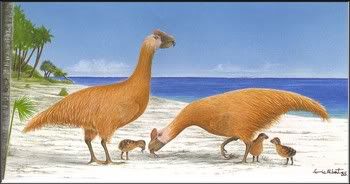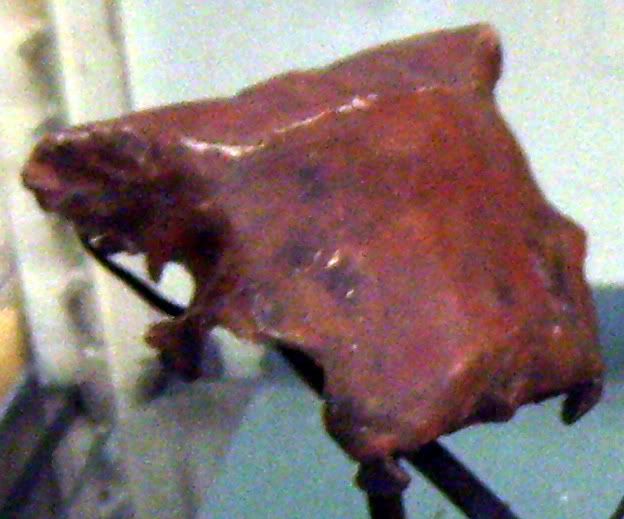|
|
Post by another specialist on Jun 6, 2005 5:10:41 GMT
Sylviornis neocaledoniae
Poplin 1980
Holocene of New Caledonia
Primary materials: Holotype: eerste phalanx
Secondary materials: Paratypes: femoral schacht, tibiotarsi, tarsometatarsus. All parts of the skeleton were found later, allowing identification as a megapode.
François Poplin,
Sylviornis neocaledoniae n. g., n. sp. (Aves), ratite éteint de la Nouvelle-Calédonie
Comptes Rendus de l'Academie des Sciences Paris sér. D, 290 (1980): 691-694
See also:
François Poplin, Cécile Mourer-Chauviré & Jacques Evin,
Position systématique et datation de Sylviornis neocaledoniae, mégapode géant (Aves, Galliformes, Megapodiidae) étient de la Nouvelle-Calédonie
Comptes Rendus de l'Académie des Sciences sér. II, 297 (1983): 301-304
And:
François Poplin & Cécile Mourer-Chauviré,
Sylviornis neocaledoniae (Aves: Galliformes, Megapoiidae), oiseaux géant éteint de l'Ile des Pins
Géobios 18 (1985): 73-97
|
|
|
|
Post by Melanie on Nov 4, 2005 23:17:02 GMT
|
|
|
|
Post by Melanie on Nov 4, 2005 23:29:00 GMT
|
|
|
|
Post by another specialist on Nov 5, 2005 21:50:14 GMT
|
|
|
|
Post by another specialist on May 1, 2006 20:58:10 GMT
 a clearer example of above pics |
|
Deleted
Deleted Member
Posts: 0
|
Post by Deleted on May 3, 2006 12:36:11 GMT
Hi ! Oral tradition speaks of something like a fleshy comb on the bird's head, here You can see how large this bird was in live - compared to a man:  'The Origin and Evolution of Birds' |
|
|
|
Post by thomasw on Oct 9, 2006 14:44:54 GMT
New publication, now it is its own family:
DESCRIPTION OF THE SKULL OF THE GENUS SYLVIORNIS POPLIN, 1980 (AVES,GALLIFORMES, SYLVIORNITHIDAE NEW FAMILY), A GIANT EXTINCT BIRD FROM THE HOLOCENE OF NEW CALEDONIA Cécile MOURER-CHAUVIRÉ & Jean Christophe BALOUET MOURER-CHAUVIRÉ, C. & BALOUET, J.C. 2005. Description of the skull of the genus Sylviornis Poplin, 1980 (Aves, Galliformes, Sylviornithidae new family), a giant extinct bird from the Holocene of New Caledonia. In ALCOVER, J.A. & BOVER, P. (eds.): Proceedings of the International Symposium “Insular Vertebrate Evolution: the Palaeontological Approach”. Monografies de la Societat d’Història Natural de les Balears, 12: 205-118. »
|
|
|
|
Post by sordes on Dec 7, 2006 15:59:57 GMT
I´ve drawn a reconstruction based on the skeleton and the skull and uploaded it in the gallery, I hope it can be seen there soon.
|
|
|
|
Post by another specialist on Sept 6, 2008 17:16:08 GMT
|
|
|
|
Post by another specialist on Sept 10, 2008 13:13:48 GMT
|
|
|
|
Post by another specialist on Sept 11, 2008 3:48:25 GMT
Sylviornis is an extinct genus of galliform bird containing a single species, S. neocaledoniae, or erroneously, "New Caledonian Giant Megapode". Technically, the latter is incorrect because it has recently been found not to be a megapode, but the sole known member of its own family, the Sylviornithidae; at the time of its description, it was believed to be a ratite. Sylviornis was never encountered alive by scientists, but it is known from many thousands of subfossil bones found in deposits, some of them from the Holocene, on New Caledonia and the adjacent Île des Pins. Sylviornis neocaledoniae bone, Muséum national d'histoire naturelle, Paris Sylviornis neocaledoniae bone, Muséum national d'histoire naturelle, Paris Sylviornis was a huge, flightless bird, 1.70 meters long altogether, and weighing around 30 kg. It had a large skull with a high and laterally compressed beak surmounted by a bony knob. Its legs were rather short, but had strong toes with long nails. The skeleton has a number of peculiarities and differences that make Sylviornis stand apart from all other known birds: the clavicles were not fused to a furcula, the number of caudal vertebrae was very high, and the ribcage and pelvis were almost dinosaurian in appearance. The wings were reduced to small stubs. A large proportion - up to 50% in some deposits - of the remains found were from juvenile animals. Thus, it has been theorized that Sylviornis had a clutch of at least two, more probably closer to 10 eggs, and that the average lifespan was not much more than 5-7 years, which would be extremely low for such a large bird. Apparently, the bird did not incubate its eggs but built a mound similar to the megapodes. Tumuli on the Île des Pins which were initially believed to be graves were found to contain no human remains or grave goods, and it has been hypothesized that they were in reality the incubation mounds of Sylviornis. As these mounds are up to 5 m high and 50 m wide even after nearly 4 millennia, they seem too large to have been made by the Giant Scrubfowl, an extinct New Caledonian species of megapode. Little can be said about the lifestyle of Sylviornis. It was probably a slow-moving browser, and the structure of the bill and feet suggest that roots and tubers it dug up formed a major part of its diet. [edit] Extinction The bird was hunted to extinction by the Lapita ancestors of the Kanak people, who settled New Caledonia around 1500 BC. Predation by feral dogs and pigs probably also played a part. The legacy of the Sylviornis persists in Kanak oral history in the form of stories giving a rough description of the bird and some of its habits. A native name was du. [edit] See also * Late Quaternary prehistoric birds * Island gigantism [edit] References * Mourer-Chauviré, Cécile & Balouet, J. C. (2005): Description of the skull of the genus Sylviornis Poplin, 1980 (Aves, Galliformes, Sylviornithidae new family), a giant extinct bird from the Holocene of New Caledonia. In: Alcover, J. A. & Bover, P. (eds.): Proceedings of the International Symposium "Insular Vertebrate Evolution: the Palaeontological Approach". Monografies de la Societat d’Història Natural de les Balears 12: 205-118. * Poplin, François (1980): Sylviornis neocaledoniae n. g., n. sp. (Aves), ratite éteint de la Nouvelle-Calédonie. Comptes Rendus de l'Academie des Sciences Paris sér. D 290: 691-694 [Article in French] * Balouet, Jean Christophe; Olson, Storrs L.: Fossil Birds from Late Quaternary Deposits in New Caledonia PDF, online en.wikipedia.org/wiki/Sylviornis |
|
|
|
Post by another specialist on Sept 11, 2008 3:57:01 GMT
 Sylviornis neocaledoniae skull, Muséum national d'histoire naturelle, Paris.  Sylviornis neocaledoniae bone, Muséum national d'histoire naturelle, Paris. en.wikipedia.org/wiki/Sylviornis |
|
|
|
Post by RSN on Sept 23, 2011 13:36:57 GMT
|
|
|
|
Post by Melanie on Mar 30, 2016 21:43:21 GMT
Trevor H. Worthy, Miyess Mitri, Warren D. Handley, Michael S. Y. Lee, Atholl Anderson and Christophe Sand, 2016 Osteology Supports a Stem-Galliform Affinity for the Giant Extinct Flightless Bird Sylviornis neocaledoniae (Sylviornithidae, Galloanseres)PLoS ONE 11 (3): e0150871. Abstract: The giant flightless bird Sylviornis neocaledoniae (Aves: Sylviornithidae) existed on La Grande Terre and Ile des Pins, New Caledonia, until the late Holocene when it went extinct shortly after human arrival on these islands. The species was generally considered to be a megapode (Megapodiidae) until the family Sylviornithidae was erected for it in 2005 to reflect multiple cranial autapomorphies. However, despite thousands of bones having been reported for this unique and enigmatic taxon, the postcranial anatomy has remained largely unknown.We rectify this deficiency and describe the postcranial skeleton of S. neocaledoniae based on ~600 fossils and use data from this and its cranial anatomy to make a comprehensive assessment of its phylogenetic affinities. Sylviornis neocaledoniae is found to be a stem galliform, distant from megapodiids, and the sister taxon to the extinct flightless Megavitiornis altirostris from Fiji, which we transfer to the family Sylviornithidae. These two species form the sister group to extant crown-group galliforms. Several other fossil galloanseres also included in the phylogenetic analysis reveal novel hypotheses of their relationships as follows: Dromornis planei (Dromornithidae) is recovered as a stem galliform rather than a stem anseriform; Presbyornis pervetus (Presbyornithidae) is the sister group to Anseranatidae, not to Anatidae; Vegavis iaai is a crown anseriform but remains unresolved relative to Presbyornis pervetus, Anseranatidae and Anatidae. Sylviornis neocaledoniae was reconstructed herein to be 0.8 m tall in a resting stance and weigh 27–34 kg. The postcranial anatomy of S. neocaledoniae shows no indication of the specialised adaptation to digging seen in megapodiids, with for example, its ungual morphology differing little from that of chicken Gallus gallus. These observations and its phylogenetic placement as stem galliforms makes it improbable that this species employed ectothermic incubation or was a mound-builder. Sylviornis neocaledoniae can therefore be excluded as the constructor of tumuli in New Caledonia. Free pdf: journals.plos.org/plosone/article/asset?id=10.1371%2Fjournal.pone.0150871.PDF |
|
|
|
Post by Sebbe on Dec 7, 2022 21:02:49 GMT
|
|